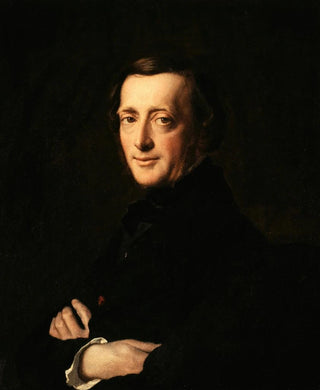Art print | Portrait of Dr M. G. Worms - Henri Lehmann


View from behind

Frame (optional)
Portrait of Dr. M. G. Worms - Henri Lehmann – Captivating introduction
In the vast panorama of art history, some works stand out for their ability to capture the very essence of their subjects. The "Portrait of Dr. M. G. Worms" by Henri Lehmann is one of those creations that transcends the simple frame of the portrait. This piece, created in the 19th century, bears witness to an era when portrait painting was not only a means of immortalizing public figures but also a refined form of artistic expression. Through this portrait, Lehmann does not merely depict his model; he manages to evoke psychological depth and palpable humanity, making each gaze upon this canvas unique and captivating.
Style and uniqueness of the work
Henri Lehmann's style is characterized by an exceptional mastery of light and shadow, as well as meticulous attention to detail. In the "Portrait of Dr. M. G. Worms," the painter uses a palette of rich and nuanced colors that give the work an atmosphere both intimate and solemn. The doctor's face is rendered with remarkable precision, each feature carefully modeled to express both wisdom and kindness. The model's posture, slightly tilted, suggests openness and availability, as if he is ready to share his knowledge with the viewer. This humanist approach to the portrait, where the artist goes beyond mere physical representation to explore the psyche of his subject, gives the work a singularity that continues to fascinate art enthusiasts.
The artist and his influence
Henri Lehmann, a French painter of German origin, played a key role in the development of the art print in the 19th century. Raised in an artistic environment, he trained at the École des beaux-arts in Paris, where he had the opportunity to explore various techniques and styles. His work is often associated with the academic tradition, but he infused a modernity into his art prints, making them accessible and moving. Lehmann was also influenced by the romantic movements of his time, which is reflected in the way he approaches his subjects with increased sensitivity. His impact on his contemporaries and future generations

Matte finish

View from behind

Frame (optional)
Portrait of Dr. M. G. Worms - Henri Lehmann – Captivating introduction
In the vast panorama of art history, some works stand out for their ability to capture the very essence of their subjects. The "Portrait of Dr. M. G. Worms" by Henri Lehmann is one of those creations that transcends the simple frame of the portrait. This piece, created in the 19th century, bears witness to an era when portrait painting was not only a means of immortalizing public figures but also a refined form of artistic expression. Through this portrait, Lehmann does not merely depict his model; he manages to evoke psychological depth and palpable humanity, making each gaze upon this canvas unique and captivating.
Style and uniqueness of the work
Henri Lehmann's style is characterized by an exceptional mastery of light and shadow, as well as meticulous attention to detail. In the "Portrait of Dr. M. G. Worms," the painter uses a palette of rich and nuanced colors that give the work an atmosphere both intimate and solemn. The doctor's face is rendered with remarkable precision, each feature carefully modeled to express both wisdom and kindness. The model's posture, slightly tilted, suggests openness and availability, as if he is ready to share his knowledge with the viewer. This humanist approach to the portrait, where the artist goes beyond mere physical representation to explore the psyche of his subject, gives the work a singularity that continues to fascinate art enthusiasts.
The artist and his influence
Henri Lehmann, a French painter of German origin, played a key role in the development of the art print in the 19th century. Raised in an artistic environment, he trained at the École des beaux-arts in Paris, where he had the opportunity to explore various techniques and styles. His work is often associated with the academic tradition, but he infused a modernity into his art prints, making them accessible and moving. Lehmann was also influenced by the romantic movements of his time, which is reflected in the way he approaches his subjects with increased sensitivity. His impact on his contemporaries and future generations






